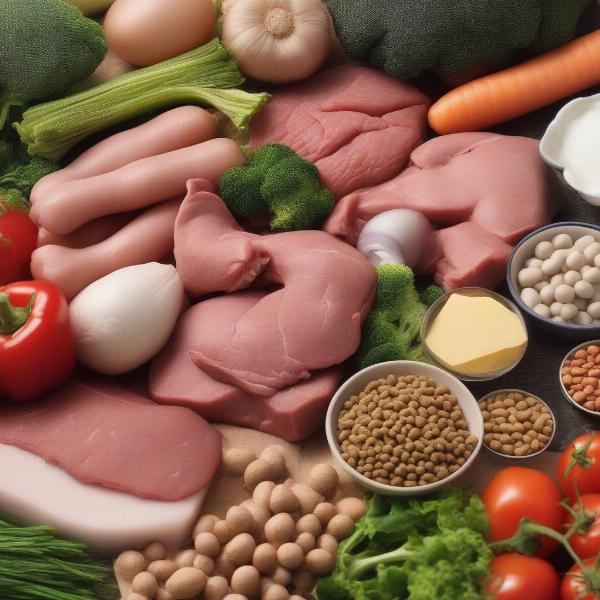No carb dog food has become a popular trend, but is it really necessary or even beneficial for your canine companion? This comprehensive guide will explore the truth about carbohydrates in dog food, the potential benefits and drawbacks of a no-carb diet, and help you make informed choices for your dog’s nutritional needs. We’ll delve into the science behind canine digestion, discuss which dogs might benefit from a low-carb approach, and how to choose a high-quality no-carb dog food.
While dogs don’t have the same carbohydrate requirements as humans, they can efficiently digest and utilize them as an energy source. Carbohydrates provide glucose, which fuels the brain and muscles. Completely eliminating carbohydrates from a dog’s diet can be challenging and may not be necessary for most healthy dogs. However, certain conditions like diabetes or obesity may benefit from a reduced carbohydrate intake.
Understanding Carbohydrates in Dog Food
Carbohydrates in dog food typically come from sources like grains (rice, wheat, corn), legumes (peas, lentils), and vegetables (potatoes, sweet potatoes). These provide fiber, which aids in digestion and promotes gut health. They also offer essential vitamins and minerals.
Are Carbs Bad for Dogs?
Not all carbs are created equal. Simple carbohydrates, often found in processed foods, can lead to rapid spikes in blood sugar. Complex carbohydrates, found in whole grains and vegetables, release glucose more slowly, providing sustained energy. For most dogs, moderate amounts of complex carbohydrates are a healthy part of a balanced diet.
 No Carb Dog Food Ingredients
No Carb Dog Food Ingredients
Benefits of a Low-Carb Diet for Dogs
For some dogs, a low-carb diet can be beneficial. It can help manage weight, regulate blood sugar levels, and improve energy levels.
Weight Management
Low-carb diets can help overweight dogs shed pounds by reducing calorie intake and promoting satiety.
Blood Sugar Control
Dogs with diabetes often benefit from low-carb diets as they help stabilize blood glucose levels.
Increased Energy
Some dog owners report increased energy levels in their dogs after switching to a low-carb diet.
Choosing the Right No Carb Dog Food
If you’re considering a no-carb dog food, it’s crucial to choose a high-quality, nutritionally complete option. Look for foods that use high-quality protein sources and are formulated to meet AAFCO standards. best rated grain free dog food offer excellent alternatives for dogs requiring grain-free or low-carb options.
Reading the Label
Carefully examine the ingredient list. Look for whole food sources of protein and avoid fillers. old glory dog food is a good example of a brand that focuses on natural ingredients.
Consulting with a Veterinarian
Before making any significant dietary changes, it’s always best to consult with your veterinarian. They can help you determine if a no-carb diet is appropriate for your dog’s individual needs and health status. This is especially important for dogs with pre-existing health conditions.
Conclusion
No carb dog food isn’t a one-size-fits-all solution. While it can be beneficial for some dogs, it’s essential to consider your dog’s individual needs and consult with your veterinarian. By understanding the role of carbohydrates in a dog’s diet and choosing a high-quality food, you can ensure your canine companion receives the optimal nutrition they need to thrive. Remember, a balanced and appropriate diet is key to a happy and healthy dog.
FAQ
- Is no carb dog food safe for all dogs? Not necessarily. Consult your veterinarian before switching.
- What are the signs of carbohydrate intolerance in dogs? Common signs include digestive upset, skin issues, and weight gain.
- Can puppies eat no carb dog food? Puppies have specific nutritional needs, so consult your vet.
- Are there any risks associated with a no-carb diet? Potential risks include nutrient deficiencies if the diet isn’t balanced.
- What are some good alternatives to grains in dog food? Alternatives include vegetables like sweet potatoes and squash.
- How can I transition my dog to a no-carb diet? Gradually introduce the new food over several days to avoid digestive upset.
- Where can I find high-quality no carb dog food? Look for brands that prioritize whole food ingredients and meet AAFCO standards. Products like nutro canned dog food offer a variety of options.
Related Articles:
best dog food for a great dane
dirty dogs menu
About ILM Dog:
ILM Dog is your trusted resource for expert advice on dog breeds, health, training, nutrition, grooming, and much more. We’re dedicated to providing dog owners worldwide with practical, reliable information to help them provide the best possible care for their furry friends. We offer guidance on various topics, from choosing the right breed to understanding your dog’s nutritional needs. Contact us for personalized support at [email protected] or +44 20-3965-8624.